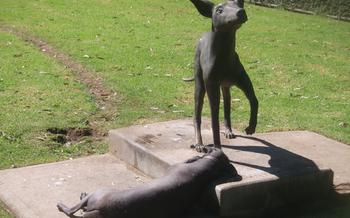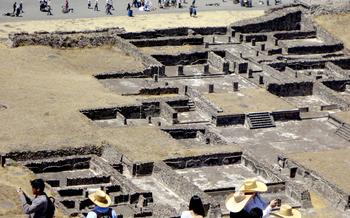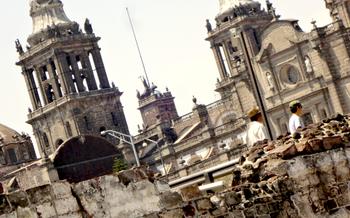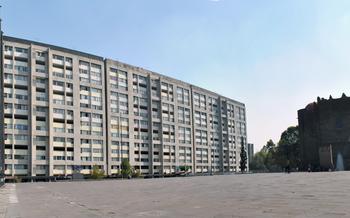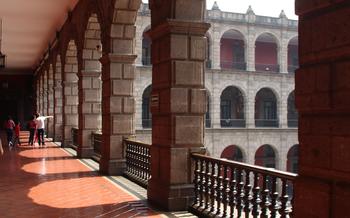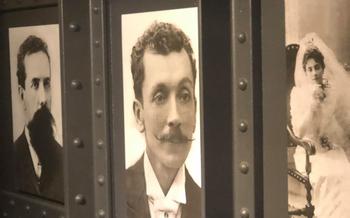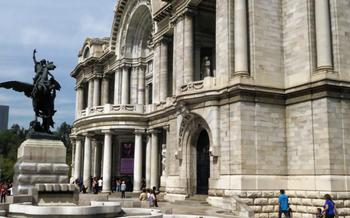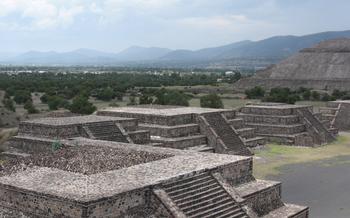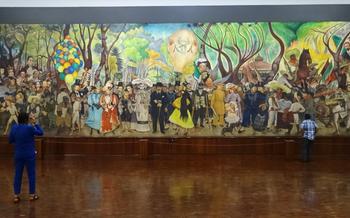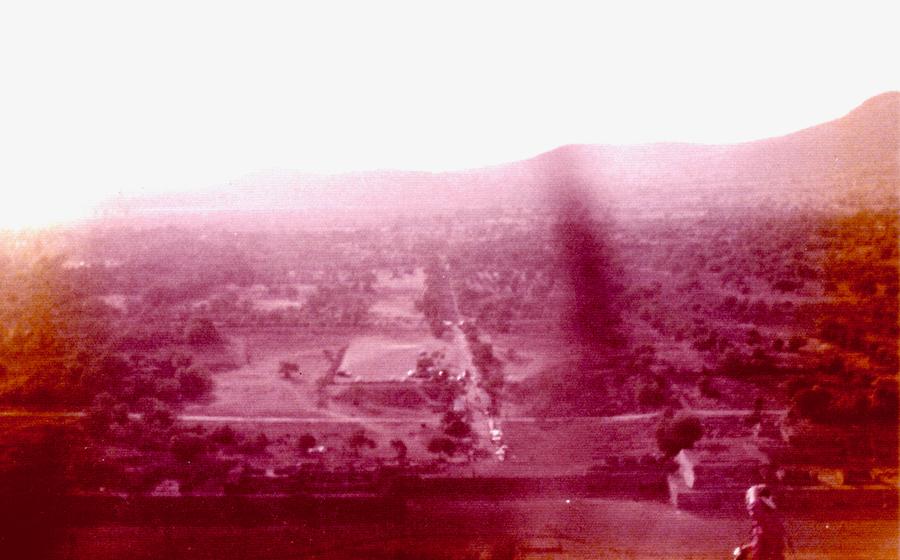
Museo Mural Diego Rivera
- Exploring the Museum
- Diego Rivera's Life and Work
- Understanding the Mural's Symbolism
- The Making of the Mural
- Exploring Teotihuacan
- Tips for photographers
- Educational Programs
- Souvenirs and Merchandise
- Dining Options
- Accessibility and Inclusivity
- Sustainability Efforts
- Insider Tip: Uncovering the Hidden Gem of Teotihuacan
Exploring the Museum
The Museo Mural Diego Rivera is a spacious and well-organized museum, designed to showcase the magnificent mural and provide visitors with an immersive experience. The museum is divided into several sections, each highlighting different aspects of Rivera's life and work.
The main attraction is, of course, the mural itself, which dominates the central hall. The mural is displayed on a curved wall, allowing visitors to view it from different angles and perspectives. The museum also features a number of smaller galleries that provide context for the mural, including Rivera's early works, his involvement in the Mexican muralism movement, and his international recognition.
One of the most striking features of the museum is its use of natural light. The large windows on one side of the building allow sunlight to flood into the galleries, illuminating the mural and creating a sense of awe and wonder. The museum also makes use of artificial lighting to create a dramatic and atmospheric effect, particularly in the evening hours.
In addition to the mural, the museum also houses a number of other artifacts and exhibits related to Rivera's life and work. These include personal items, such as his brushes and palette, as well as photographs, sketches, and preparatory studies for the mural. The museum also features a number of interactive displays and multimedia presentations that provide visitors with a deeper understanding of Rivera's techniques and artistic vision.
Diego Rivera's Life and Work
Diego Rivera, one of the most celebrated muralists of the 20th century, was born in Guanajuato, Mexico, in 188His early passion for art led him to study at the San Carlos Academy of Fine Arts in Mexico City and later in Europe, where he encountered the works of European masters and the avant-garde movements of the time. Upon his return to Mexico, Rivera embraced the country's rich cultural heritage and indigenous roots, which became central themes in his artistic expression.
His involvement in the Mexican muralism movement, alongside fellow artists such as José Clemente Orozco and David Alfaro Siqueiros, aimed to create a new form of public art that would educate and inspire the Mexican people. Rivera's murals often depicted scenes from Mexican history, mythology, and everyday life, employing a unique style characterized by bold colors, simplified forms, and a strong narrative quality.
Beyond the Museo Mural Diego Rivera, Rivera's most famous murals can be found in Mexico City, including the Palacio Nacional, the Ministry of Education, and the Anahuacalli Museum, which houses his personal collection of pre-Columbian artifacts. His work also graces institutions in the United States, such as the Detroit Institute of Arts and the San Francisco Museum of Modern Art.
Rivera's international recognition and legacy are cemented by his contributions to the art world. His murals have been exhibited worldwide, and his influence can be seen in the work of subsequent generations of artists. Rivera's commitment to social justice, his celebration of Mexican culture, and his innovative artistic style have solidified his position as a towering figure in the history of art.
Understanding the Mural's Symbolism
Diego Rivera's mural is a complex and multi-layered masterpiece that encapsulates Mexican history, culture, and social commentary. It is a visual narrative that weaves together indigenous symbols, political allegories, and historical events.
The mural prominently features symbols of Mexican identity, such as the Aztec calendar, the eagle and the serpent, and the Virgin of Guadalupe. These symbols represent the country's rich cultural heritage and its struggle for independence.
Rivera also uses the mural to critique social and political issues of his time. He depicts scenes of poverty, oppression, and exploitation, highlighting the plight of the Mexican people. He also includes references to the Mexican Revolution, which he saw as a symbol of hope and social transformation.
The mural's relevance extends beyond its historical context. It continues to resonate with contemporary audiences, inviting viewers to reflect on themes of identity, social justice, and the human condition. Its powerful imagery and symbolism make it a timeless masterpiece that speaks to the heart of Mexico's past, present, and future.
The Making of the Mural
The creation of the mural was a complex and challenging process that spanned several years. Rivera began by conducting extensive research on Mexican history and culture, studying ancient artifacts, and immersing himself in the local traditions. He then prepared numerous sketches and studies, experimenting with different compositions and color schemes.
Once the design was finalized, Rivera and his team of assistants began the painstaking process of transferring the mural onto the wall. Using a technique known as fresco, Rivera applied layers of wet plaster to the wall and then painted directly onto the fresh surface. This technique allowed him to achieve the vibrant colors and intricate details that are characteristic of his work.
Rivera faced a number of challenges during the creation of the mural. The sheer size of the project was daunting, and he often had to work long hours in difficult conditions. He also encountered technical problems, such as the cracking of the plaster and the fading of the colors. Despite these challenges, Rivera persevered and completed the mural in 194
The completion of the mural was a significant event in Rivera's career and in the history of Mexican art. It is considered one of his most important works and has been praised for its technical virtuosity, its historical accuracy, and its powerful political message. The mural has also had a profound impact on subsequent generations of artists and has helped to shape the way that Mexican history and culture are viewed around the world.
Exploring Teotihuacan
Beyond the confines of the Museo Mural Diego Rivera, Teotihuacan beckons with its ancient allure. This awe-inspiring city, once the largest in the pre-Columbian Americas, invites you to delve into its captivating history and unravel its enduring mysteries. Explore the iconic Pyramids of the Sun and the Moon, marveling at their architectural prowess and astronomical significance. Wander through the sprawling Avenue of the Dead, where grand temples, palaces, and residential compounds once lined this sacred pathway. Discover the vibrant murals and intricate carvings that adorn these structures, offering glimpses into the lives and beliefs of the Teotihuacan people. As you immerse yourself in the grandeur of this ancient metropolis, you'll gain a profound appreciation for the ingenuity and artistry of a civilization that left an indelible mark on Mexican history and culture.
Tips for photographers
The Museo Mural Diego Rivera is a photographer's paradise, with its vibrant colors, intricate details, and historical significance. To capture the best shots, photographers should come prepared with the right equipment and knowledge. A tripod is essential for capturing sharp images, especially in low-light conditions. A wide-angle lens is also recommended for capturing the mural's grand scale.
Before taking any photos, obtain permission from the museum staff. They will be able to advise you on the best angles and lighting. When composing your shots, pay attention to the lines and shapes of the mural. The use of leading lines can help draw the viewer's eye into the composition. Experiment with different angles and perspectives to create unique and dynamic images.
Finally, remember to edit your photos carefully to bring out the colors and details of the mural. Share your photos online using social media or photography platforms, and don't forget to tag the museum and use relevant hashtags. This will help you connect with other photographers and art enthusiasts, and it will also help promote the museum to a wider audience.
Educational Programs
The Museo Mural Diego Rivera offers a range of educational programs designed to engage visitors of all ages. Workshops, lectures, and classes are regularly conducted, providing insights into the history, art, and cultural significance of the mural and Mexican art in general. These programs are an excellent way to deepen your understanding and appreciation of Rivera's work and its context.
School groups and families are particularly encouraged to take advantage of these programs. Guided tours tailored to specific age groups and interests can be arranged, ensuring an enriching and interactive experience for students and families alike. Additionally, the museum's website offers a wealth of online resources and educational materials, including virtual tours, interactive quizzes, and downloadable activity sheets. These resources can be used to enhance your visit to the museum or to continue your learning journey at home.
For visitors with disabilities, the museum is committed to providing an accessible and inclusive environment. Audio guides and materials are available in multiple languages to cater to diverse visitors. Additionally, the museum offers accessible tours and activities designed to accommodate visitors with physical or cognitive challenges. By creating a supportive and inclusive environment, the Museo Mural Diego Rivera ensures that everyone has the opportunity to engage with and appreciate the museum's offerings.
Souvenirs and Merchandise
The Museo Mural Diego Rivera offers a well-stocked gift shop where visitors can purchase a variety of souvenirs to commemorate their visit. From postcards and posters featuring the mural to replicas of pre-Hispanic artifacts, there is something for everyone. The shop also sells books on Rivera and his work, as well as traditional Mexican crafts and souvenirs.
In addition to the museum gift shop, visitors can find unique souvenirs in the nearby town of Teotihuacan. The town is home to a vibrant market where vendors sell everything from handmade pottery and textiles to traditional Mexican sweets and snacks. Visitors can also find souvenirs at the many shops and boutiques that line the streets of Teotihuacan.
When shopping for souvenirs in Teotihuacan, it is important to support local artisans and craftsmen. Look for items that are handmade and unique, rather than mass-produced souvenirs. Bargaining is also acceptable in the market, so don't be afraid to haggle for a good price.
Dining Options
The Museo Mural Diego Rivera does not have its own restaurant or cafe, but there are several dining options within walking distance. For a quick bite, there are several food stalls and street vendors selling traditional Mexican snacks like tacos, tortas, and quesadillas. There are also a few sit-down restaurants in the area, offering a wider variety of Mexican and international cuisine.
If you're looking for a more authentic experience, head to one of the many family-run restaurants in Teotihuacan. These restaurants often specialize in traditional Mexican dishes made with fresh, local ingredients. Be sure to try some of the local specialties, such as barbacoa (slow-cooked lamb or goat), mole (a rich, spicy sauce made with chocolate and chili peppers), and pulque (a fermented beverage made from the sap of the maguey plant).
For a truly unique dining experience, consider booking a cooking class at one of the local restaurants or cooking schools. This is a great way to learn more about Mexican cuisine and culture while enjoying a delicious meal.
If you're on a tight budget, there are a few picnic areas near the museum where you can enjoy a packed lunch. You can also bring your own food and drinks into the museum, but be sure to dispose of your trash properly.
Accessibility and Inclusivity
The Museo Mural Diego Rivera strives to provide an accessible and inclusive experience for all visitors. The museum is equipped with ramps, elevators, and accessible restrooms, ensuring that visitors with disabilities can navigate the space with ease. Audio guides are available in multiple languages, allowing visitors from diverse backgrounds to fully appreciate the mural's significance. Family-friendly amenities, such as stroller parking and changing tables, make the museum a welcoming environment for families with young children. To create a positive and inclusive experience for all, the museum staff is trained to be attentive and respectful of visitors' needs.
Sustainability Efforts
The Museo Mural Diego Rivera is committed to promoting sustainable practices and minimizing its environmental impact. The museum has implemented several initiatives to reduce its carbon footprint and conserve natural resources. These efforts include using energy-efficient lighting and appliances, recycling and composting waste, and reducing water consumption. Additionally, the museum promotes sustainable tourism by encouraging visitors to use public transportation or bicycles to get to the museum and to support local businesses that prioritize sustainability.
Insider Tip: Uncovering the Hidden Gem of Teotihuacan
Beyond the grand pyramids and bustling crowds of Teotihuacan lies a hidden gem that offers a tranquil retreat from the tourist trail. Nestled amidst lush gardens and ancient ruins, the Museo del Pulque y el Maguey invites visitors to immerse themselves in the fascinating world of pulque, a traditional Mexican alcoholic beverage made from the fermented sap of the maguey plant.
Learn about the history, production, and cultural significance of pulque through interactive exhibits and displays. Sample different varieties of this ancient elixir, each with its unique flavor and aroma. Discover the traditional methods of pulque making, as well as its role in Mexican mythology and rituals.
As you sip your pulque, take a moment to wander through the tranquil gardens, surrounded by towering cacti and ancient stone structures. Admire the vibrant murals that adorn the museum walls, depicting scenes from the daily life and rituals of the ancient Teotihuacanos.
Whether you're a history buff, a cultural enthusiast, or simply looking for a unique and authentic experience, the Museo del Pulque y el Maguey is a must-visit destination in Teotihuacan. Immerse yourself in the rich traditions and flavors of Mexico as you uncover the secrets of this ancient beverage.
